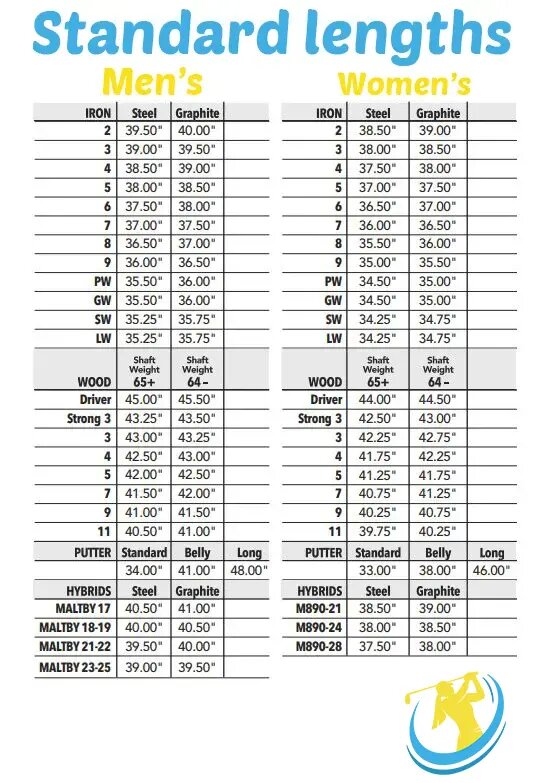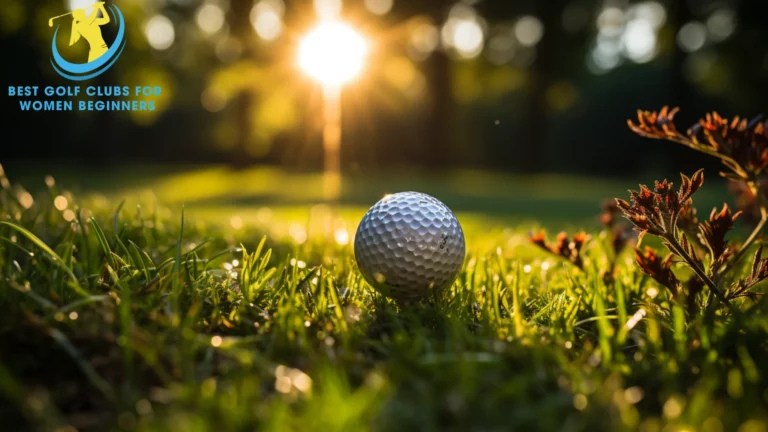How to Choose Golf Clubs [The Definitive Guide in 2024]

Popular Articles
Welcome to our 2024 Definitive Guide on How to Choose Golf Clubs for Women Beginners!
If you’re new to golf and feeling a bit overwhelmed by all the equipment options out there, you’ve come to the right place. This guide is designed for beginners like you, aiming to make the process of choosing the perfect set of golf clubs easy to understand.
We know that starting a new sport can feel a bit scary, especially with golf being known for its complexity. But don’t worry! We’re here to explain everything in simple and friendly terms, so you can feel confident and ready to hit the course. Whether you’re aiming for a great drive down the fairway or just want to enjoy some outdoor time, our tips will help you start your golfing journey with ease.
Understanding The Basics of Golf Clubs
In this chapter, we’ll help you get the basics down. So, if you’re not sure about the different types of golf clubs, what size golf clubs you need, or how many golf clubs you can have in your bag, this chapter will help.
Then, in a later chapter, we’ll show you a range of advanced strategies and techniques for selecting the best golf club.
Now, let’s dive in.
Different Types of Golf Clubs:
There are typically five main types of golf clubs, each serving a specific purpose in a golfer’s bag:
1. Woods: Traditionally made of wood, but now mostly made of metal (such as titanium or steel). Clubs are designed for long-distance shots from the tee or fairway. They typically have larger clubheads and longer shafts.
- Driver: The longest club in the bag, used for tee shots on par-4s and par-5s.
- Fairway Woods: These clubs have a slightly higher loft than the driver and are used for long shots from the fairway or tee on long par-3s or shorter par-4s.
2. Irons: These clubs have metalheads and are typically numbered from 3 to 9 (with lower numbers having less loft and longer shafts). Versatile clubs are used for various distances and situations on the course. They have smaller clubheads and shorter shafts compared to wood.
- Long Irons (3-5): Used for longer shots from the fairway or rough.
- Mid-Irons (6-7): Provide a balance between distance and loft.
- Short Irons (8-9): Used for shorter approach shots to the green where accuracy is crucial.
3. Hybrids: These clubs combine features of both irons and woods, typically with a design that makes them easier to hit than long irons. They’re often used as alternatives to long irons for shots requiring distance and accuracy.
4. Wedges: Specialized clubs designed for short-distance shots around the green or out of hazards. They include pitching wedges, sand wedges, gap wedges, and lob wedges.
5. Putters: These clubs are used on the putting green to roll the ball into the hole. Putters come in various shapes and designs to suit different putting styles and preferences.
Golf Club Size Chart:
Golf clubs come in various sizes to accommodate different players. They are available in standard, petite, and tall sizes to suit players of different heights.
Getting your clubs properly fitted ensures that they match your height, arm length, and swing characteristics, which improves performance and comfort. In addition, we’ll show you a table of standard golf club lengths.

Number of Clubs in a Golf Bag:
Ever wondered how many clubs are in a golf bag? Well, according to the USGA rules of the game, golfers are allowed to carry a maximum of 14 clubs in their golf bag during a round of golf. This typically includes a mix of woods (driver and fairway woods), irons (usually ranging from 3 to 9), wedges (pitching wedge, sand wedge, and potentially a lob wedge), and a putter. The specific combination of clubs can vary based on the player’s skill level, preferences, and the demands of the golf course being played.
For new women golfers, having around 8 clubs in your bag is usually good enough. These should include a driver, fairway wood, hybrid, three irons, a wedge, and a putter. If you end up with a set that has 10 or 11 clubs, that is completely fine. But having a total of 14 clubs might not be necessary for you at this point in the game.
Golf Club Components:
- Shaft: This isn’t just about how long the club is; it’s also about what it’s made of and how flexible it is. The material and flex of the shaft can greatly influence how the club behaves during your swing. A stiffer shaft might provide more control for powerful swings, while a more flexible one could help generate greater clubhead speed for distance.
- Club Head: This is where the action happens—the part of the club that makes contact with the ball. The size, shape, and weight distribution of the clubhead all play a role in determining the trajectory and flight of your shots. A larger clubhead might offer more forgiveness on off-center hits, while a smaller one could provide greater precision and control.
- Grip: This is the part of the club that you actually hold onto. It might seem small, but the right grip can make a huge difference in your ability to control the club and feel comfortable during your swing. Grips come in various materials and textures, offering different levels of tackiness and cushioning. Finding the right grip size and style for your hands can improve your grip pressure, reduce unwanted twisting, and ultimately enhance your overall performance on the course.
How To Determine Which Golf Club to Use (15 Steps on Choosing The Best Golf Clubs For Women Beginners)

Choosing the right golf clubs as a beginner, especially for women, is crucial for enjoying the game and improving your skills. We understand the challenges that female beginners face when starting out in golf. That’s why our focus is on providing valuable tips to help you choose the best golf clubs for your needs.
And now, the chapter of guiding on choosing the perfect golf clubs is here, it’s time to take things to the next level. This chapter will cover some advanced selection tips, strategies, and best practices.
In the final section of this guide, we will discuss how to maintain and clean your favorite golf equipment.
Here’s a guide with 15 easy steps to help you choose the best golf clubs to meet your needs:
Step 1: Research Women’s Golf Clubs
Start by researching different models or types of women’s golf clubs. Look for clubs designed specifically for beginners or high-handicap players, as these typically offer more forgiveness and ease of use. This blog contains everything you need. You can read through each section to learn, or you can use the “Table Content” to quickly find the information.
Step 2: Assess Your Skill Level And Goals
Determine whether you’re an absolute beginner or have some experience in golf. Consider your goals in the game, whether it’s casual play, improvement, or competitive aspirations.
Step 3: Understand Men’s and Women’s Golf Club Differences
Recognize that women’s golf clubs are typically designed with lighter shafts, smaller grips, and more flexible shafts compared to men’s clubs. These factors can help accommodate differences in strength and swing speed.
Step 4: Get Familiar with Club Types
Understand the four basic types of clubs: woods, irons, wedges, and putters. Each type has a specific function on the golf course, with woods used for longer shots, irons for mid-range shots, wedges for shorter shots and putting, and putters for, well, putting! If you are looking for more specific golf club types or golf club buying tips, please see the Golf Club Type section above or the Frequently Asked Questions section below.
Step 5: Consider Club Weight and Flexibility
Given that women generally have slower swing speeds and less physical strength compared to men, choose for lighter clubs with more flexible shafts. This can help you generate more clubhead speed and distance.
Step 6: Determine Shaft Flex
Consider your swing speed when choosing the flex of the club shafts. As a beginner, you’ll likely benefit from more flexible shafts that help generate distance and forgiveness on off-center hits.
Step 7: Set a Budget
Determine your budget for purchasing golf clubs. Establishing a budget will narrow down your options and help you focus on clubs that offer the best value within your price range.
Step 8: Start with a Half Set or Combo Set
As a beginner, consider starting with a half set or a combo set. These sets typically include fewer clubs, focusing on the essentials like a driver, a couple of irons, a hybrid or two, and a putter. This simplifies your choices and can be more cost-effective.
Step 9: Compare Features
Compare the features of different club sets, paying attention to factors like forgiveness, distance, and ease of use. Look for clubs with large club heads and perimeter weighting for added forgiveness.
Step 10: Seek Feedback and Reviews
Seek feedback and read reviews from other golfers who have experience with the clubs you’re considering. Pay attention to insights on performance, durability, and overall satisfaction to make an informed decision.
Step 11: Take Measurements
Measure your height and arm length to determine the appropriate club length for you. Most online retailers provide size charts to help you choose the right length clubs. Use sizing guides provided by the retailer to ensure you’re selecting the right length and size clubs for your height and arm length.
Step 12: Consider Extras
Consider what additional features or accessories you might need, such as a golf bag, headcovers, or a glove, when choosing your clubs. Determine if the set includes any extras like a golf bag, headcovers, or a glove. These accessories can add value to your purchase and save you money in the long run.
Step 13: Consider Joining a Game-Improvement Clubs
Look for clubs specifically designed for beginners or high-handicap players. These clubs often have larger clubheads, wider soles, and more forgiveness on off-center hits, which can help minimize mishits and boost confidence.
Step 14: Think Long-Term
While you’re a beginner now, consider how your game might progress in the future. Choose clubs that have room for growth and improvement as you become more skilled and experienced.
Step 15: Make the Purchase
Finally, trust your instincts and choose clubs that make you feel comfortable and confident. Golf is a highly personal sport, and selecting the right clubs is frequently an iterative process. Once you’ve chosen the right set of golf clubs for you, proceed with the purchase and eagerly await their arrival.
This is the final step in our simple guide to selecting the best golf clubs for your needs. Now, to help you even further, we’ve curated a list of top rated golf clubs for women beginners. These clubs have been carefully selected based on their quality, ease of use, and overall performance on the course. So, if you’re eager to explore your options and find the perfect set of clubs to suit your needs, make sure to check out our detailed review list here.

The Top 15 Best Golf Club Brands in 2024
All of the brands on this list have a long history of producing high-quality products that are popular among amateur and professional golfers worldwide. Some are globally known, while others are becoming more popular as golf grows.
- TaylorMade: Noted for being the top-selling driver and fairway brand, with a strong emphasis on woods, often favored by both professionals and amateurs.
- Callaway: Renowned for woods and solid reputation in irons, offering a wide range of high-quality clubs, with a broad appeal across different player levels.
- Titleist: Highly regarded across all categories, with particular strength in irons, wedges, and putters.
- Ping: Known for forgiveness across the board, particularly for game improvement clubs, especially irons.
- Cobra: Particularly known for solid drivers and woods, often at a slightly lower price point compared to competitors.
- Mizuno: Primarily recognized for exceptional irons known for their craftsmanship and performance, with a strong following among players who value craftsmanship and performance.
- Cleveland: Renowned for exceptional wedges, offering superior feel, versatility, and spin control. Also provides high-quality drivers, fairway woods, and irons known for performance and value.
- Wilson Staff: Historically known for their irons, although not as prominent as in the past.
- PXG (Parsons Xtreme Golf): Known for high-end, premium clubs with innovative technology and custom fitting options, PXG appeals to golfers seeking top performance and exclusivity.
- Srixon: Primarily recognized for high-quality irons, delivering precision engineering, forgiveness, and distance control. Also offers a range of golf balls and equipment designed to enhance performance on the course.
- XXIO: Celebrated for lightweight, high-quality clubs designed to enhance performance, especially for players with moderate swing speeds.
- Honma: A premium Japanese brand offering high-quality clubs known for craftsmanship and luxury appeal.
- Tour Edge: Known for innovative technology and high performance, especially in fairway woods and hybrids, catering to players of all skill levels.
- Ben Hogan Golf: Committed to precision and quality, offering a range of clubs appealing to skilled golfers seeking exceptional feel and performance.
- Adams Golf: Recognized for innovative designs, particularly hybrids and fairway woods, catering to a wide range of players.
4 Best Golf Clubs Brands For Any Beginners:
- Callaway Strata: Known for offering good quality at an entry-level price point, the Strata sets include everything a beginner needs to get started.
- Wilson Profile SGI: Wilson’s beginner sets are another excellent choice, offering quality and value with options tailored to different player heights and swing characteristics.
- Cobra Fly XL: Cobra offers beginner sets that include easy-to-hit clubs with designs that aid in getting the ball airborne and improving distance.
- TaylorMade RBZ Speedlite: While a bit more of an investment, TaylorMade’s sets for beginners are designed for performance and durability, offering a path for skill improvement without the immediate need to upgrade.
Check out our curated list of the best golf clubs for women beginners here! We’ve selected these clubs based on trusted brands, quality, ease of use, and on-course performance.
11 Tips to Improve Golf Clubs Maintenance Efficiency
- Clean your clubs after every round: Use a soft-bristled brush or towel to remove dirt, grass, and debris from the club heads, grooves, and grips. This prevents buildup and maintains optimal performance.
- Inspect for damage: Regularly check your clubs for any signs of wear, such as dents, scratches, or loose ferrules. Addressing minor issues promptly can prevent further damage and extend the lifespan of your clubs.
- Keep your grips clean: Wipe down your grips with a damp cloth or specialized grip cleaner to remove dirt, sweat, and oils. This prevents them from becoming slippery and ensures a secure hold during your swing.
- Regroove your clubfaces: Over time, the grooves on your clubfaces can wear down, affecting spin and control. Use a groove cleaner or tool to restore the sharpness of the grooves for better performance.
- Store your clubs properly: Avoid leaving your clubs in extreme temperatures or damp conditions, as this can cause damage to the shafts and grips. Store them in a dry, climate-controlled environment, preferably in a golf bag with headcovers for protection.
- Regularly check your shafts: Inspect your shafts for any signs of rust, corrosion, or bends. If you notice any issues, consult a professional club fitter or repair technician for evaluation and possible repairs.
- Avoid hitting rocks or hard surfaces: Be mindful of where you’re swinging to prevent unnecessary damage to your club heads. Avoid hitting rocks, roots, or other hard surfaces that could cause dents or fractures.
- Rotate your clubs: To ensure even wear and tear, rotate your clubs regularly, especially if you have a preferred set of irons or wedges. This helps distribute usage across all your clubs and extends their lifespan.
- Re-grip when necessary: If your grips become worn, slick, or hardened, it’s time to replace them. Fresh grips provide better traction and control, enhancing your overall performance on the course.
- Schedule regular maintenance: Consider scheduling annual or biannual check-ups with a professional club fitter or repair shop. They can perform thorough inspections, adjustments, and repairs to keep your clubs in top condition.
- Use the Right Cleaning Tools: Use a soft-bristled brush for cleaning club faces and a softer cloth for woods and putters. Avoid using wire brushes or abrasive materials that can damage the club’s surface.

Frequently AQs (Buying Guide Tips)
Q1: What should a beginner woman look for in golf clubs? Or What should a beginner woman consider when choosing golf clubs?
For beginner women golfers, choosing the right golf clubs involves considering clubs with higher loft degrees and lighter flex shafts. These features help in achieving greater distance and accuracy with less effort. Look for drivers with lofts between 12° and 16°, they’re like the big guns of your bag. Choose a set with a driver, irons, wedges, woods or hybrids, and a putter. Try out different clubs to find ones that feel comfortable and suit your swing speed and style.
Q2: Are there golf clubs specifically designed for women beginners?
Yes, many brands offer golf clubs specifically designed for women beginners. These clubs are typically lighter, with more flexible shafts and higher lofts, tailored to women’s average swing speeds and strength. These specialized clubs can significantly improve playability and confidence on the course.
Q3: How many clubs do women beginners need to start playing golf?
A typical beginner’s set for women should include a driver, one or two fairway woods, a few hybrids (which are easier to hit than long irons), several irons (usually ranging from 5 to 9), at least one wedge (such as a pitching wedge or sand wedge), and a putter. This range of clubs covers various distances and shot types, providing beginners with versatility on the course without overwhelming them with too many options.
Q4: What is the importance of club fitting for women?
Club fitting is crucial as it ensures your golf clubs are tailored to your height, strength, swing speed, and playing style. Properly fitted clubs can dramatically improve your comfort, swing consistency, and overall performance on the course.
Q5: Can a woman use a man’s golf club set effectively?
While some women can use men’s clubs, it’s generally not recommended. Men’s clubs are often heavier and have stiffer shafts, which can hinder a beginner woman’s ability to swing effectively and enjoy the game.
Q6: What type of golf club shaft is best for beginner women?
Graphite shafts are ideal for beginner women because they are lighter and help to increase swing speed and distance. They also provide better vibration damping, which can be more comfortable for beginners.
Q7: How does club loft affect my game as a beginner?
Higher lofted clubs, such as drivers with 12° to 16° and irons with larger face angles, make it easier to get the ball airborne and reduce the likelihood of slicing the ball. These are generally more forgiving and suitable for beginners.
Q8: What is the best way to practice as a beginner with my new clubs?
As a beginner, start with range practice focusing on mid-irons, then progressively use longer clubs as your confidence grows. Incorporate putting and chipping drills to develop a well-rounded game.
Q9: Should I invest in a complete set as a beginner?
Well, it really depends on what suits you best! Getting a complete set from a reputable brand can make things easier since all your clubs will match in feel and performance. It’s like having everything you need in one neat package, which can be super handy when you’re just starting out. But if you’re not sure how much you’ll stick with golf or you’re on a tight budget, starting with a half set or combo package might be a smart move. These sets give you the basics to start with—like a driver, a couple of irons, some hybrids, wedges and a putter—so you can dip your toes into the game without diving in too deep. Alternatively, if you prefer more customization or specific preferences, buying individual clubs allows you to tailor your set to your liking. And hey, as you get more into golf, you can always add more clubs later on!
Q10: What are the differences between putters, and which should I choose?
Beginners should look for a putter with a mallet design that offers more forgiveness on mis-hits and helps with easier alignment on the green. Experiment with different lengths to find one that feels the most natural and comfortable.
Q11: How do I care for my golf clubs to ensure they last?
Regularly clean your clubs after use, check grips for wear and tear, and store them in a dry place. Avoid leaving them in extreme temperatures, like in a car trunk, to prevent damage.
Q12: Is there a difference in golf clubs for different skill levels?
Yes, clubs for more advanced players usually feature less forgiveness and require more precise swings, whereas beginner clubs focus on greater forgiveness and ease of use. As your skills develop, you might consider upgrading certain clubs to enhance your play style.
Q13: Do I need a specific type of putter as a beginner?
Putters come in various shapes and designs, but as a beginner, focus on finding one that feels comfortable and suits your putting stroke. Traditional blade putters and mallet putters are both popular choices for beginners, so try out different options to see what works best for you.
Q14: What should I look for in a driver?
When choosing a driver, look for one with a larger clubhead size and forgiveness, which can help beginners achieve more distance and accuracy on off-center hits. Also, consider adjustable features that allow you to customize loft and weight distribution.
Q15: How often should I upgrade my golf clubs as I improve?
There’s no set rule for when to upgrade your clubs, as it depends on factors like your skill level, budget, and technological advancements in club design. As a general guideline, consider upgrading your clubs every few years or when you feel your current set is holding back your progress.
Q16: What’s the difference between men’s and women’s golf clubs?
Women’s golf clubs are usually designed with lighter shafts, smaller grips, and sometimes have different clubhead designs to accommodate the typically slower swing speeds of women golfers. These adjustments can help women beginners achieve better control and distance.
Conclusion
That’s all for our guide on picking the best golf clubs for beginner women golfers that you can find. I hope you found it helpful and enjoyable!
Now it’s your turn. I’d like to hear your take.
How do you determine the best golf clubs?
Or maybe you have a question about something from today’s guide.
Either way, let me know by leaving a quick comment below.




7 Responses
As a beginner in golf, I’ve been searching for the best golf clubs for women, and your recommendations have been incredibly helpful. Can’t wait to hit the course with my new clubs!
Wow, this blog is amazing! I’m so glad I stumbled upon it. I am seriously impressed with the effort put into sharing such valuable content. Thanks a bunch for sharing; it’s been a real pleasure checking it out!
Thanks for sharing this amazing content. It’s so useful for newbies like me. I am waiting for the next post to review the best women’s golf shoes, golf bag, golf gloves,…
I really loved your post. May I know when you will share your insight about the best women’s golf shoes on the market?
Many thanks for your insightful post! As a woman getting into golf, I’m concerned about potential injuries. So, how do you prevent common injuries in golf for women?
I appreciate you sharing this blog; it’s fantastic, and I’m extremely impressed. Thank you for sharing this information. Great work.
I’m looking for advice on how to choose the best golf clubs for beginners, especially women like me. Do you have any specific considerations or insider information that could help me make an informed decision? Any suggestions on which factors to prioritize, techniques to try, or resources to consult would be extremely helpful